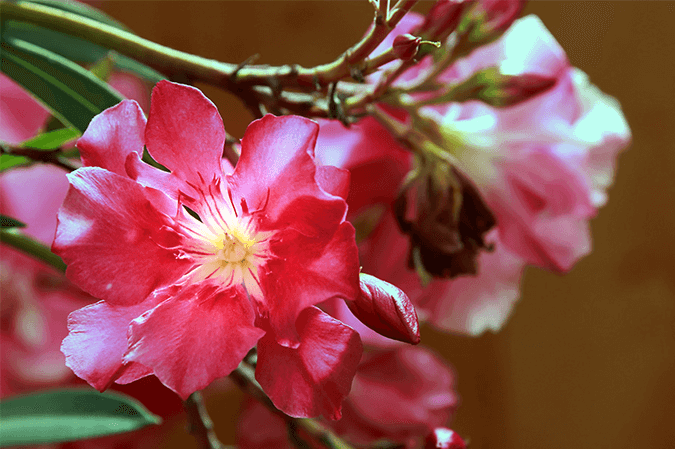Oleander is a highly ornamental and versatile shrub known for its showy flowers and evergreen foliage. Native to the Mediterranean region and parts of Asia, Oleander is widely cultivated in warm climates around the world. Despite its beauty, Oleander is also known for its toxicity, making it a plant that requires careful handling.
Description
- Appearance: Oleander is a large, evergreen shrub that can grow up to 6 to 20 feet tall and 6 to 10 feet wide. It has a dense, bushy structure with dark green, lance-shaped leaves that are leathery and glossy.
- Flowers: The flowers of Oleander are the plant’s most striking feature. They are typically 1 to 3 inches in diameter and come in various colors, including pink, red, white, and yellow. The flowers are borne in clusters at the ends of the branches and bloom from spring through fall.
- Leaves: The leaves are long, narrow, and arranged in pairs or whorls of three along the stems. They have a smooth edge and are typically 4 to 10 inches long.
- Fruit: Oleander produces long, narrow seed pods that are not particularly ornamental but contain numerous seeds that are dispersed by the wind.
Common Features
- Evergreen Foliage: Oleander retains its leaves year-round, providing continuous greenery and making it a popular choice for hedges and screens.
- Drought Tolerance: Oleander is highly drought-tolerant once established, making it suitable for regions with low water availability. It can also tolerate salt spray, making it ideal for coastal areas.
- Toxicity: All parts of the Oleander plant, including the leaves, flowers, and sap, are highly toxic if ingested. The plant contains cardiac glycosides, which can cause serious health issues in humans and animals, including nausea, vomiting, and potentially fatal heart irregularities.
Role in the Ecosystem
- Habitat and Shelter: Oleander provides dense cover and nesting sites for birds and small animals, offering protection from predators and harsh weather conditions.
- Pollinator Attraction: The flowers of Oleander attract a variety of pollinators, including bees, butterflies, and moths. These pollinators play a crucial role in the ecosystem by aiding in the reproduction of flowering plants.
- Erosion Control: Oleander’s extensive root system helps stabilize soil, making it useful for erosion control on slopes and in areas prone to soil loss.
- Limited Food Source: Due to its toxicity, Oleander is not a significant food source for herbivores. However, some insect species have adapted to feed on Oleander without being affected by its toxins.
Importance
- Ornamental Use: Oleander is widely used in landscaping for its attractive flowers, evergreen foliage, and ability to form dense, impenetrable hedges. It is commonly planted in gardens, parks, and along highways.
- Cultural Significance: Oleander has been cultivated for thousands of years and is often associated with Mediterranean landscapes. In some cultures, it symbolizes caution due to its toxic nature.
- Medicinal Research: Despite its toxicity, compounds derived from Oleander have been studied for potential medicinal uses, including treatments for heart conditions and cancer. However, these uses are highly experimental, and the plant should never be used for self-medication.
- Environmental Adaptation: Oleander’s ability to thrive in poor soils, resist drought, and tolerate salt makes it an important plant for landscaping in challenging environments.
Interesting Facts
- Ancient History: Oleander has been cultivated since ancient times. It is mentioned in the writings of Pliny the Elder, a Roman author and naturalist, who noted its medicinal uses and toxic properties.
- Symbolism: In literature and art, Oleander has been used as a symbol of both beauty and danger due to its attractive appearance and deadly nature.
- Oleander Moth: The Oleander moth (Syntomeida epilais), also known as the Polka-Dot Wasp Moth, feeds on Oleander leaves. The caterpillar of this moth is resistant to the plant’s toxins and stores them in its body as a defense against predators.
- Global Distribution: Although native to the Mediterranean, Oleander has been introduced and naturalized in many parts of the world, including the southern United States, where it is a common landscape plant.
Sources
- Royal Horticultural Society – Oleander Plant Information
- Missouri Botanical Garden – Nerium Oleander Overview
- National Center for Biotechnology Information (NCBI) – Oleander Toxicity and Medicinal Research
- Gardenia.net – Growing and Caring for Oleander



